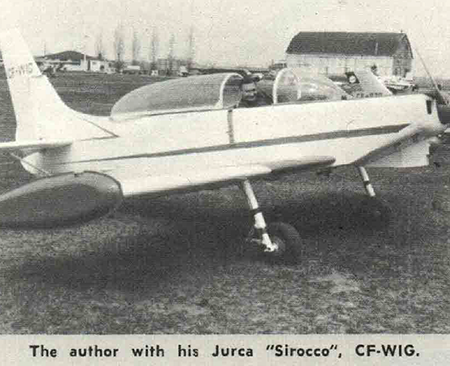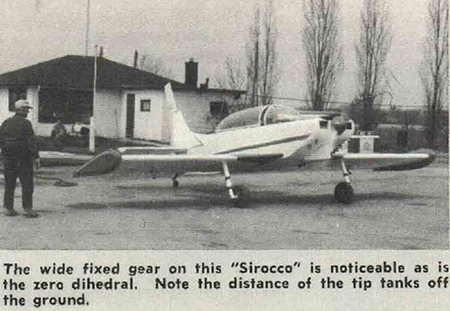From the Archives — 50 Years Ago, Jurca Sirocco Flight Report
By Geoffrey Royston, EAA 17461, Richmond Hill, Ontario
April 2020 - It's always interesting to read a first flight report, especially when it's from 50 years ago. It appears that this aircraft, a Jurca Sirocco, flew for many years, and in fact was photographed in Oshkosh in 1992, more than 20 years after the first flight. The certificate of registration wasn't cancelled until 2012. — Ed.
AFTER a construction period lasting three and one-half years, the great day finally came to take my Sirocco out of the basement and into the back yard. This move had been carefully planned and measured from the start, and should go off without any trouble, and it did in fact go that way. The hero in the operation as far as my wife was concerned was a friend who volunteered to replace the window and three concrete blocks while I got busy assembling the airplane. We started removing blocks at 8 a.m., and had the airplane out and blocks reset by noon. It was a tight fit getting the fuselage through the hole, but the important thing was that it came out.

After a trial assembly and engine run in the back yard, the airplane was taken apart again and moved in three loads to Maple Airport, my intended base for operations. It may seem like a lot of extra work to assemble in the back yard, and then disassemble to move it to the airport, but it is well worth the effort since small discrepancies and shortages show up and can be corrected without long journeys to and from the airport.
The DOT inspected the machine and gave approval, and I might add that they found a turnbuckle not safety wired despite my careful inspection beforehand. Within eight days I had the flight permit all legal, and then it suddenly dawned on me that this is in effect "calling your bluff." Do you really intend to fly this thing? It is very easy to be brave about the test flight before you need to do it, but now there was no excuse to hold back.
The propeller at this time was a 74 x 44; I knew that 44 inches was too fine but thought that it would do for the test flying initially. After all, why pay to get it repitched before I had any ideas what it would do. The engine is a Lycoming GPU, and it would turn 2750 rpm static at this pitch. My total experience at this time was 100 hours solo and about 40 hours dual, and I had flown one hour in the previous year — on the previous day in a Jodel D-ll. Taxiing tests were carried out in earnest early one Sunday morning since this was the only time the runway was relatively free. The weather conditions were slight rain, and about a 15 mph wind at about 20 degrees to the runway. The wind I found to be a big help, since it allowed me to reach a higher airspeed on a short 1,800-foot runway than would have been possible in calm conditions.
Under these conditions, I could just about get airborne before having to throttle back in time to stop at the far end. I might add here that the CG was within 3/8 of an inch of the correct position without any addition of ballast. The angle of incidence was also exactly as called up on the drawings for both tail and main plane, and there is no offset on the fin.

During the fast runs I was amazed at how easy the machine was to handle on the ground. There is hardly any swing on opening the throttle, and she runs dead straight on acceleration or deceleration, and this despite a slight cross-wind component. The larger rudder is very effective, making brakes almost superfluous for ground maneuvering. After four or five runs, I decided I could do this all day and not learn any more, there being only one thing left to do. So, on the next run the throttle was pushed all the way open rapidly and I felt her lift off smoothly and easily at about 80 mph indicated. My next worry was ... will the engine keep running? Fortunately, it did. We were showing 2800 rpm, and I let speed build up in a gentle climb until I reached 300 feet, which was almost immediately. After cutting back to about 75 percent power, I could still climb easily at 100 mph at 2700 rpm.
By now the field was well behind me, and at 500 feet I tried a gentle turn to the right. This went off without trouble, and I climbed up to 3,000 feet. My one worry during construction was, how will it be with no dihedral? Well, I can tell you it's wonderful; it's no effort to fly and will remain absolutely level all the time you hold the stick neutral, provided there are no gusts.
To return to the test flight, at 3,000 feet I first tried gentle turns left and right, gradually steepening them to 45 degrees of bank, and I discovered that this machine does aileron turns and no rudder is needed. She is very quick on the ailerons and very light; you get the impression that it is rolling ahead of the stick, but you can stop and start rolling motion instantaneously and precisely.
Elevator control is also very positive and quick, and pressures are light. In order to land, I figured that I needed to know what speed it stalled at, so I throttled right back and held the nose in a three-point attitude until at 60 mph indicated she broke cleanly and dropped her nose straight ahead. Easing in back pressure brought easy recovery with a loss of perhaps 200 feet. Now I was all set to land; engine oil and cylinder head temperatures were normal. I had lots of gas, and had had enough nervous exhaustion for a bit.
I flew a normal circuit at 100 mph at 1,000 feet above ground, slowed to 90 mph on final, and over the fence at 80 mph. I was making a long, shallow power approach, and at this point I was cut off by another aircraft making a steep approach. Fortunately, I had him under observation and was not surprised, so then we did our first go-around before our first landing.
There was no problem — she pulled up and out, and I worked myself back into the approach again. We still had a slight cross-wind, but it did not pose a problem. Again, over the fence at 80 mph carrying some power, I rounded out and she touched nicely at 65 mph indicated and then you get the only problem. She needs a lot of room to slow down, and for this reason I prefer a grass strip to a paved runway.
Since the first flight I have put well over 100 hours on the aircraft. Climb on my Sirocco at 1,300 pounds gross weight is 700 fpm at 70 degrees F. She will climb over 1,000 fpm solo. I now have the propeller at 54 inch pitch, but can only turn 2500 rpm in level flight and can therefore only expect about 125 mph. Reducing the diameter would let it turn faster, but I would lose on takeoff and climb, and since I am not going anywhere most of the time I don't want to do it. I have had the airplane up to 200 mph in a dive and there were no problems. Flying dual is quite a different feel to flying solo, but the stall is not noticeably different. More power is needed on final approach and flare-out. I would recommend that your first landings be made with power, and all landings dual with power.
The plane has neutral stability and it will go to any attitude without resisting, but it will not come back. You must remain in control at all times. This airplane does not misbehave; it just does exactly what you make it do, so be sure and do the right thing!
It has been flown by better than a half-dozen other people, all of whom thought it a real thrill and an easy machine to fly, but tailwheel experience is a must. Crosswind landings in my Sirocco are accomplished by crabbing down the runway and kicking straight at the final touchdown. This is because my tip tanks will not allow me to put a wing down. These tanks each hold seven imperial gallons to give a total fuel capacity of 25 imperial gallons, counting an 11 gallon tank in the nose. Fuel is transferred from the tips to the main tank by means of an automobile fuel pump fitted with a handle and mounted in the cockpit. From the main, it flows by gravity to the carburetor.
To sum up, this is a good airplane and it will do everything Jurca says it will. If flown properly, it does not show any vices. Go ahead and build one!
